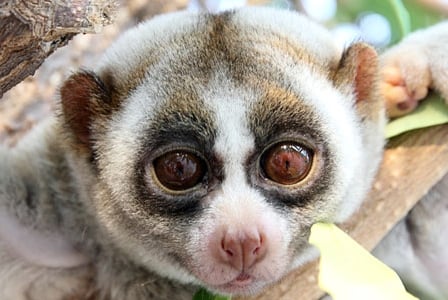
This Wildlife Wednesday, learn some fast facts about the slow loris – a primate whose fame in viral videos might be contributing to its endangered status.
This Wildlife Wednesday, we learn about the newly famous slow loris. Singer Rihanna recently posted a picture of herself cuddling up to an illegally captured loris in Thailand. The image led to the arrest of two loris poachers and plenty of controversy—confirming (among other things) that selfies are rarely a good idea.
Habitat
Slow lorises hang out mostly in the forests of Southeast Asia.
Slow loris trivia
- It may resemble a stuffed teddy bear, but the slow loris has a toxic bite. Its venom—which is one reason we wouldn’t want this animal as a pet—is sometimes deadly.
- My, what big eyes you have! The term ‘loris’ comes from the Dutch word for ‘clown,’ probably because of the slow loris’s (adorably) oversized features.
- The slow loris is valued in some parts of Asia as an animal that can cure 100 diseases. This (probably bogus) belief has led to its being caught for medicinal purposes.
Why they’re threatened
Slow loris species are listed as either vulnerable or endangered. Although the buying and selling of any loris has been illegal since 2007, they’re popular in the pet trade.
Slow loris videos are also making the rounds online. You might’ve seen a loris being tickled, eating a rice ball, holding an umbrella, or using a fork. (Guilty—I’ve watched most of these, and my response was an articulate awww.) This publicity makes the loris better known, but is all the hype helpful or hurtful?
A recent paper concludes that viral videos and celebrity attention prompt us to think of these animals as potential pets. Researchers looked at 12,411 YouTube comments on a ‘tickling slow loris’ video. “It\’s so cute—where can I get one?” wrote many viewers; variations of this were the second-most-popular comment.
How we can help
The good news? We can all do our part to let the slow loris monkey around in the wild for years to come. The Little Fireface Project is the longest-running conservation effort, with tips and information on how to contribute. Before clicking the ‘like’ button on videos with endangered animals, it might also be helpful to leave a thoughtful comment that directs viewers to conservation information.
